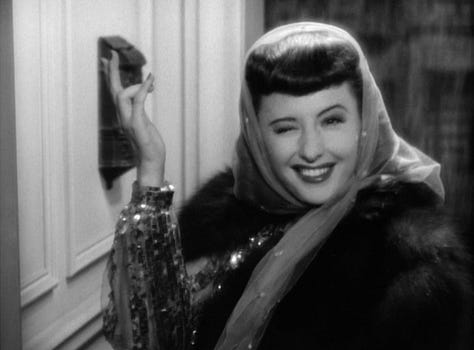BOOK REVIEW AND ANALYSIS: Not My Type: One Woman vs. a President by E. Jean Carroll
Carroll's Truth, Satire and Practice of Parrhēsia Takes Control of Her Narrative That Decimates the Flatulent and Pumpkin-Foundation-Slathered 47th President
To celebrate summer 2025, I am offering a paid support special. Until Labor Day, all paid support is 50% off forever. You can sign up for paid support or upgrade your current free subscription below. All paid support goes toward my teenage daughter’s future higher education.
E. Jean Carroll, Not My Type: One Woman vs. a President
Saint Martin’s Press, Cloth, 354 pp., $30.00 US/$42.00 CAN
Parrhēsia (Noun)
Rhetoric
“Candor, frankness; outspokenness or boldness in speech.”1
Feminist scholar and university professor Dianna Taylor argues in her article “Resisting the Subject: A Feminist-Foucauldian Approach to Countering Sexual Violence” that French philosopher and historian Michel Foucault’s investigation of how “liberation paves the way for freedom”2 can be applied to and used by sexual violence survivors. Foucault’s three-pronged praxis to achieve this includes refusal, curiosity and innovation.3 Taylor then centers her claim on Foucault’s Collège de France courses from the early 1990s that analyzed the rhetorical strategy of parrhēsia in Ancient Greece4
Taylor elaborates how parrhēsia allows the speaker to access the truth and double their own truth’s effect; the speaker’s combined standpoint and words reveal not only their truth but objective truth5 that dishonesty, evasion and falsehoods work overtime to suffocate.
For this to occur, both parties must stay involved and relate to each other in the public sphere.6 Parrhēsia’s “access to truth entails exercising freedom” regardless of any future danger and additional battles7 this freedom unearths.
By combing knowledge and exposure, parrhēsia allows the injured party to use their artistry and vision.8 Only doing so allows the sexual violence survivor to study and criticize the perpetrator who wronged them.9 It turns them from a survivor of sexual violence to a resister of sexual violence.10
To demonstrate this with a concrete example, Taylor brings in Foucault’s analysis of Creusa confronting the Greek god Apollo who raped her. In Euripides’s Ion, Creusa utilizes parrhēsia and all of Foucault’s three elements.
So does our modern Creusa
.Carroll’s memoir Not My Type: One Woman vs. a President utilizes parrhēsia and Foucault’s three-point practice. With her witty writing style and vivid recreations outside of and inside the federal court, her refusal to no longer remain silent and defamed blazes. We witness her curiosity to balance her harrowing story with an empowering and a satirical one. Once again we enjoy her creativity in braiding journalism and humor. Like Creusa, Carroll demonstrates a sexual violence survivor can metamorphize into a wordsmith sexual violence resister.
The end result reduces the psychopathic 47th President of the United States —a hollow, weak and frightened man—to the clown he is. A danger to humankind of course. But still a clown.
A clown that is an emotionally and a psychologically stunted man who only has power because of those enabling and empowering him. Carroll noted this to Rachel Maddow after she won her second defamation case against Trump.
Taylor’s theory of ugliness and imperilment to arrive for the eternally liberated Carroll once she achieves freedom was practiced by the vile but ungrammatical internet trolls harassing her. Though one troll's message that told her “yuk u” tickled her.
The death threats though did not. They caused her to emotionally and mentally meltdown. Carroll includes actual shots of these death threats from her Facebook account that also threatened rape.
One thing an illiterate or aliterate person never wants to do is provide evidence for a writer. And Carroll uses that evidence splendidly.
Of course, she has truth and talent on her side to combat Trump and his smooth-brained anonymous trolls. But Carroll’s comedic skill and intellect weaponize both.
The trauma Trump inflicted upon her must not be forgotten or minimized. Because of that trauma, Carroll shares that she did not have sex again after her 1996 sexual violation.
Never ignoring the heinousness of Trump’s adjudicated rape, Carroll reduces him to the hideous, ridiculous and gross “nothing” he is. The most decimating and uproarious sentence occurs toward the end of Not My Type.
A precise simile, dramatic structure and concrete details recreate day eight of the second defamation trial. Carroll begins the scene with the Honorable Lewis A Kaplan, who oversaw both of Carroll’s defamation trials, dressing down Trump lawyer Alina Habba. Throughout her book, Carroll sardonically refers to Habba as Alina Habba, Esq.
After Judge Kaplan threatens jail for Habba’s arrogant and kuckleheaded contempt, Carroll concludes the scene with perhaps one of the greatest denouements in all of world literature:
“And Trump expels air like a jet exhaust.”
Carroll, the Emmy-nominated and now best-selling humor journalist, knows hyperbole, irony, euphemism and incongruity are essential components for satire and ridicule. All four ripened her defamation cases. These absurdist components are why the humorist and journalist Carroll made herself vulnerable to Trump. The terror and facts of the incident in real life though are why Judge Kaplan found that Trump raped her in 1996.
The court transcripts Carroll use provide that day's full story. Through the direct examination and cross examination from the first defamation trial, we understand Trump’s premeditated predation on Carroll at Bergdorf Goodman’s.
Telling her he was looking to buy lingerie for a woman, Carroll and Trump visited the luxury department store’s lingerie department. After lighthearted (and insulting) banter between them, he tells Carroll to try on the lingerie. She tells him he should try it on instead. They then enter a dressing room with an open door. She believed he would try to put the sheer teddy on over his suit and fail. Genuine material for satire.
For Trump, it was instead an opportunity for sexual violence. For Carroll, the golden comedy material for a non-fiction story turned into that of horror. He shut the door and pushed her against the wall so hard the back of her head smacked twice into the wall.
That is when he yanked down her tights, jammed his fingers far up her vaginal canal, pulled down his zipper, removed his rummaging fingers and inserted his penis.
Misogyny and double standards drip upon the 1996 event and the two trials. Carroll called her friend the writer and fellow humorist Lisa Birnbach right after the adjudicated rape. Carroll, however, didn’t use “rape” to describe what happened to her. Only Birnbach did.
Birnbach still told Carroll to stay silent because of Trump ‘s known vengeance. Trump’s lawyers like right-wing media claim Carroll is not a rape victim. A rape victim cannot display strength, optimism and humor. A rape victim must fall apart and never laugh. Not even a nervous laugh like she one she released during Trump’s adjudicated rape.
The misogyny doesn’t end there. The reason Carroll bobbed her hair and colored it blonde for the two trials was because a trial jury did not find in her favor when she openly appeared as a woman in her late seventies:
The whole discussion of plastic surgery follows, naturally. I don’t believe in plastic surgery. Also I don’t believe I have the money. Lisa [Corvelli] cuts my hair into the exact bob I was wearing in 1996, and does the exact makeup she did in 1996, and, after several trials (trials!) she blonds me up to the color I was wearing in 1996. And, no, I do not look like I looked in 1996, but I look like somebody who could have once looked like I looked in 1996.
The ultimate absurdity is that Carroll is asked about her sexual history by Trump’s lawyers. She’s asked about her wardrobe the day of the assault. But she points out that Trump’s sexual history and wardrobe are never questioned.
To the reader’s delight though, Carroll does focus on Trump’s hair, comparing it to the manes of classic Hollywood actresses:
“. . . his hair combed into the plume-like Tippi Hedren in The Birds . . . .”
“. . . his hair rolling across his forehead like Barbara Stanwyck in Ball of Fire.”
“. . .his hair twirled across his forehead like Bette Davis in Now, Voyager . . . “



Trump may have the powers of the federal government and money, but he does not have, has never had and will never have Carroll’s much stronger power. The pen.
In her essay “Experience,” French historian and gender studies scholar Joan Wallach Scott asserts that what knowledge women gain through experience has been dismissed “or overlooked in accounts of the past”11; but experience produces fuller and ultimately more truthful knowledge. Memoir’s focused re-creation humanizes and qualifies the sexual violence resister to readers not touched by sexual violence. As a result, it inspires other survivors to tell and control their stories in their own voices.
Since their explosion in the 1990s, women’s memoir and autobiography have been labelled with the demeaning term “narcissistic”. In 1998, Rita Felski, a scholar of aesthetics, English literature, postmodernism, literary theory, feminism and cultural studies, refuted this belief. Openness and reflection she wrote reveals “a source of truth and meaning in a society whose public values and institutions no longer possess any such authority.”12
Almost three decades later, Felski’s words remain prescient. Not My Type breaks the slate cloud of social despair, lies and misogyny that has now petrified into one of black onyx that hovers over the United States in 2025. Carroll reduces Trump to the “phantom” he is. Best of all, she regains and controls her own story and reputation. She and her memoir will inspire and emancipate other sexual violence survivors to also become resisters.
“parrhesia,” Oxford English Dictionary, Lexico, https://www.lexico.com/en/definition/parrhesia, Accessed November 6, 2019.
Dianna Taylor, “Resisting the Subject: A Feminist-Foucauldian Approach to Countering Sexual Violence,” Foucault Studies, no. 16 (September 2013): 93.
Taylor, 93.
Taylor, 95.
Taylor, 95.
Taylor, 95.
Taylor, 95.
Taylor, 95.
Taylor, 95.
Ann Russo, Taking Back Our Lives: A Call to Action for the Feminist Movement, (New York: Routledge, 2001), 201.
Joan Scott, “Experience,” in Women, Autobiography, Theory: A Reader, eds Sidonie Smith and Julia Watson, (Madison: University of Wisconsin Press, 1998), 58.
Rita Felski, “On Confession,” in Women, Autobiography, Theory: A Reader, eds Sidonie Smith and Julia Watson, (Madison: University of Wisconsin Press, 1998), 89.








Brilliant and a stimulating read.